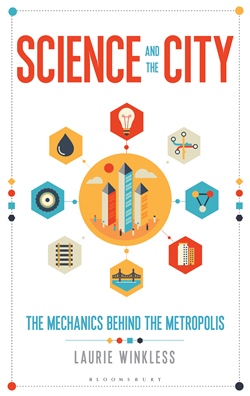 Science and the City is aimed at anyone interested in all aspects of the technology—past, present and under development—used in constructing and running modern cities, ranging from buildings and water supply to cars and the internet. Although it is Laurie Winkless’s first book, she brings to it some years of research in thermoelectric energy harvesting at the National Physical Laboratory plus more than a decade of experience as a science communicator with schools and universities. Her combination of serious homework with a chatty style—bolstered by interviews with an impressive variety of urban experts—mostly works well.
Science and the City is aimed at anyone interested in all aspects of the technology—past, present and under development—used in constructing and running modern cities, ranging from buildings and water supply to cars and the internet. Although it is Laurie Winkless’s first book, she brings to it some years of research in thermoelectric energy harvesting at the National Physical Laboratory plus more than a decade of experience as a science communicator with schools and universities. Her combination of serious homework with a chatty style—bolstered by interviews with an impressive variety of urban experts—mostly works well.
The sections on underground transport and skyscrapers are the main geoscientific attraction. Focusing on London’s current Crossrail project, which Winkless is thrilled to tour with its engineers, she jokes: “How do you bore a tunnel? Talk about trains!” But her detailed discussion of the planning for proposed tunnel routes, and their digging, is anything but boring. A preliminary geological survey with ground-penetrating radar can reveal buried utilities. In Mexico City it unearthed an Aztec pyramid, in Istanbul a Byzantine shipwreck.
Above a tunnel-in-progress, buildings must be constantly monitored with sensors able to detect movement of even thousandths of a millimetre, linked to an alarm at the control centre. In response, a team of grouting engineers working in vertical tunnels a few metres wide injects a cement-like substance through small-diameter pipes radiating into the ground directly beneath the threatened structures. This stabilises the area in which further sinking is predicted, compensating for the loss of soil. “It’s like a filler for the wrinkled face of a city.” Such prophylactic grouting has frequently saved historic buildings across the world that might otherwise have disappeared “in the name of progress”.
As for seismic engineering, the chief engineer of the world’s tallest structure, the 828-metre Burj Khalifa in Dubai, tells Winkless that “even in an area with moderate seismic activity, wind usually dominates designs.” That said, huge damping pendulums inside a tall skyscraper, which move in the opposite direction to its sway, have proved useful against both high winds and earthquakes in skyscrapers and bridges in Taiwan and Japan, as Winkless notes. But in her passion for progress, she sometimes neglects tradition. Japan’s first skyscraper, built in Tokyo in 1968, used a flexible steel-frame lattice apparently inspired by the flexible wooden structure of the city’s 17th-century Kan’eiji Temple that enabled it to survive the Great Kanto earthquake of 1923 intact.
Reviewed by Andrew Robinson (author of Earth-Shattering Events: Earthquakes, Nations and Civilization.)
SCIENCE AND THE CITY: THE MECHANICS BEHIND THE METROPOLIS by LAURIE WINKLESS. Published by: Bloomsbury Sigma, 2016. 298pp, £16.99
ISBN 978 1 4729 1321 0